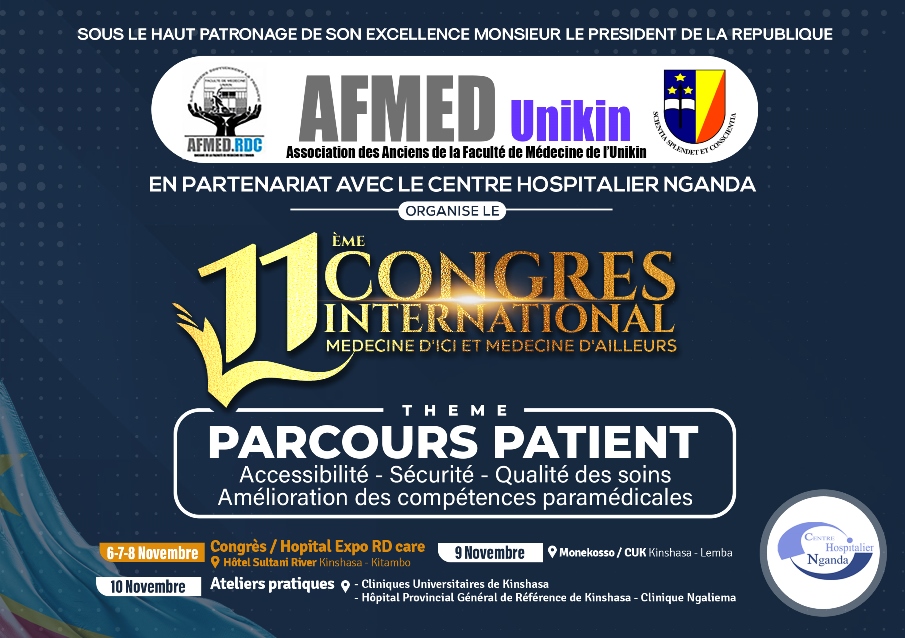Le 03 janvier 2017 a eu lieu la défense du mémoire du Dr Alain Nyengele ayant comme titre : APPLICABILITE ET DETERMINATION DE L’INDICE DE PONT MODIFIE (KORKHAUS) PROPRE AUX SUJETS MELANODERMES CONGOLAIS/RDC »

Contexte : L’indice de Pont permet de prédire les valeurs idéales de la largeur de l’arcade au niveau de prémolaires et de molaires à partir des mesures des incisives supérieures.
Objectif : Evaluer l’applicabilité de l’indice de Pont dans sa version modifiée par Korkhaus sur la population congolaise.
Matériel et méthodes : étude descriptive transversale menée sur soixante-quatre moulages de maxillaires supérieurs des étudiants à l’Université de Kinshasa (Unikin) (38 hommes et 26 femmes) dont l’âge a varié de 20 à 34 ans avec un âge moyen 26,56 ± 3,36 ans. Les diamètres mésio-distaux des incisives supérieures et les largeurs d’arcade dentaires maxillaires ont été mesurés à l’aide d’un pied à coulisse digital tandis que les longueurs antérieures d’arcade ont été obtenues à l’aide d’un compas balustre. Les valeurs prédites étaient obtenues grâce à l’orthomètre de Korkhaus. Les tests de Students et d’Anova ont été utilisés pour vérifier l’influence du sexe. La corrélation de Pearson a été utilisée pour vérifier les liaisons entre les valeurs mesurées et celles prédites par l’indice de Pont. Le P value < 0,05 a été considéré significatif.
Résultats :
Les hommes avaient des largeurs antérieures et postérieure d’arcade (39,66mm±2,17 et 51,23mm±2,61 respectivement) plus large que celles des femmes (respectivement 38,07mm±2,39 et 49,59mm±2,44) (p=0,01 et p=0,01). Par contre, aucune différence statistiquement significative n’a été trouvée entre les deux sexes pour la longueur antérieure d’arcade (p=0,46). Les dimensions d’arcade n’avaient aucune différence significative entre les étudiants <originaires de différentes provinces. Aucune corrélation significative n’a été trouvée entre les largeurs d’arcades mesurées et celles prédites (r=0,11 et p=0,37 pour la largeur antérieure et r=0,01 et p=0,93 pour la largeur postérieure). Une corrélation a été trouvée entre la longueur d’arcade mesurée et prédite (r=0,35 et p<0,01). Aucune corrélation statistiquement significative n’a été trouvée entre l’arc incisif et la largeur antérieure d’arcade (p=0,34), entre l’arc incisif et la largeur postérieure (p=0,91). Pour la longueur antérieure d’arcade, l’indice corrigé était de 171,6.
Conclusion : L’indice de Pont modifié ne peut pas être appliqué dans cette population de l’étude pour prédire les largeurs d’arcade. Pour la longueur antérieure l’indice corrigé était de 171,6 au lieu de 160.
Mots clés : Indice de Pont, diamètres mésio-distaux, largeur d’arcade dentaire, longueur antérieure d’arcade dentaire.
Context: Pont’s index lets announce ideal values of the width of the arcade with the level about premolars and about molars from measurements of upper incisors.
Objective: rating applicability of Pont’s index in its version changed by Korkhaus in Congolese’ population.
Methods
Descriptive cross-sectional survey had led to the university of Kinshasa (Unikin) on sixty four moldings of upper jawls of students (the 38 men and the 26 women) with average age of 26,56 years ± 3, 36. The mesio-distal diameters of upper incisors and the widths of maxillary dental arch were measured with digital vernier micrometer but anterior lengths were measured with a compass baluster. The predicted values had obtained by Korkhaus’ orthometer. The T-Students test and analysis of variance had been used to check the influence of the sex. Pearson’s correlation had been used to check the links between measured values and the ones predicted by Pont index. p < 0, 05 was seen significant.
Results:
The men had anterior and posterior width of arch (39,66mm w±2,17 and 51,23mm±2,61 respectively) wider than the one of women (respectively 38,07mm±2,39 et 49,59mm±2,44) (p = 0, 01 and p = 0, 01). No statistically indicative difference was found between the two sexes according to the anterior length of an arcade (p = 0, 46). The sizes of an arcade did have no significant difference from student’s native of different province. No correlation significant was found between widths arch sized and the ones predicted (r = 0, 11 and p = 0, 37 according to the anterior width and r = 0, 01 and p = 0, 93 according to posterior width). A correlation was found between the length of an arcade measured and augured (R = 0, 35 and p < 0, 01). No correlation statistically significant was found between incisal arch and anterior arch width (p = 0, 34) and between incisal arch and the posterior width arch (p = 0, 91). The index emended was of 171, 6 according to the anterior length of an arcade
Conclusion: Pont’s index modified can’t have been used in this studies population to announce the widths of arch. The index emended was of 171 alternatively in 160 according to the anterior length.
Key words: Pont index, diameters Mesio-Distal, width of dental arch, anterior length of dental arcade









